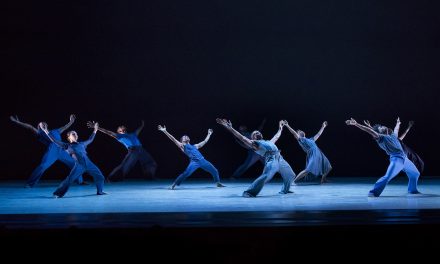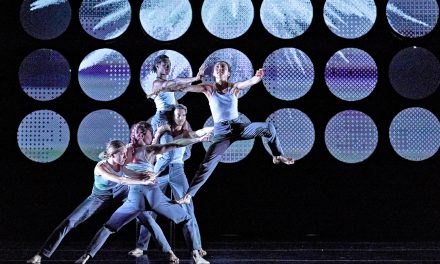The final performance for the fifth Los Angeles Dance Festival (LADF) International took place at Brockus Project Studios (BPStudios) on Saturday, June 24, 2023. This concluded an intense three day exchange between LADF and the Seoul International Dance Festival in TANK which involved several dance classes, workshops, and performances at the Korean Cultural Center, Los Angeles and BPStudios. The two countries will meet again in Korea during the fall of this year.
Saturday’s program included five “InstaDances” that were the product of workshops led by four choreographers/companies during which a short dance was created in two class sessions. The local companies were Volta Collective (led by Mamie Green and Megan Paradowski), and Bernard Brown/bbmoves; the Korean based companies were Art Dock, Yoon Su-mi Dance Company, and KIMI Dance. The results were truly amazing considering that the dancers had to learn this movement in just two workshop sessions.
Volta Collective’s piece involved a very percussive music score with 10 dancers utilizing trust movements where a dancer blindly fell backwards to be caught by another, unison movement phrases and duets. The dancers who performed this work were Kardale Holland, Claudia Maria Schmidt, Mara Anne Hancock, Denak Huff, Mia Moraru, Kyle James Abraham, Thomas Nj, Bianca Cheung, Anna Lee Rohovec, and Sophia Fan Lin.
The dance created by Project Artdock choreographer Jeon Ye Hwa, was given the title of Peacock with a cast of eight dancers, Hannah Rios, Kyle James Abraham, Mia Morani, Anna Lee Rohovec, Alice Lousen, Thomas Nj, Arturo Gonzalez and Daveth. The dancers took positions and executed movements that resembled birds flocking together, vying for leadership, mating and in flight.
Eight dancers took part in the work by Yoon Su-mi of Yoon Su-mi Dance Company which consisted primarily of a long unison phrase driven by a highly percussive score. The movement was athletic and demanding resulting in a very positive reaction from the audience. The cast included Soy Kim, Lee Da Young, Kim Na Kyung, Kim Suan, Claudia Maria Schmidt, Kyle James Abraham, Mia Morani, and Alice Lousen.
Bernard Brown’s work was the most complex piece with duets and several different groupings of dancers working in both unison and in canon. The ten dancers who deserve special mention here were Soy Kim, Lee Da Young, Kim Suan, Kim Na Kyung, Moon Sun Young, Hannah Rios, Kyle James Abraham, Anna Lee Rohovec, Thomas Nj, and Arturo Gonzalez.
KIMI Dance’s work was created by Mi-sun KIM and performed by dancers: Kyle James Abraham, Alice Lousen, Mia Moraru, Thomas Nj, and Daveth. The work covered the most space and involved groupings, solos, duets and trios. One section that stood out was a long repeated movement phrase during which dancers joined in and left at will. It reminded me of sections in several works by Viola Farber.
Following a brief intermission there were performances by three choreographers: Seda Aybay, Sam McReynolds, and KIMI Dance.

Kybele Dance Theater – Seda Aybay and Karlo Ramierz in Aybay’s SINIR/SIZ (BORDER/LESS) – Photo by Denise Leitner
SINIR/SIZ (BORDER/LESS) was an intriguing work choreographed by Seda Aybay, artistic director of Kybele Dance Theatre. Two long strands of rope held in place by five folding chairs sectioned off the space to form a division of environments for Seda Aybay and Karlo Ramierz to exist in before meeting. One sensed their isolation expressed through hand gestures toward their heads and hearts, along with a desire for change, a way out, as each tested their boundaries tentatively and aggressively. When they met, Aybay took the rope and almost performed what is called Cat’s Cradle but instead broke through their limitations. From there the two found trust, companionship and perhaps even love.
This beautiful work will only become stronger with time and theater production elements added. I look forward to seeing it on stage. The music for SINIR/SIZ was composed by Oliver Doerell and Stephan Wohrmann, members of the music group Swod.
There is no one who moves like Sam McReynolds – no one! The man can command the stage/space by simply standing still and then suddenly his body seems as if it is moving in six different directions. He went from standing profile to the audience to lying flat on his back in a micro-second and without a single sound. I want to make something happy was an 8 minute solo created and performed by McReynolds that followed a man from lying half way inside a plastic bag of empty liquor bottles to his hopefully walking away from his addiction. McReynolds left the question open as to whether or not long-term sobriety was accomplished as the solo depicts not only a struggle with the bottle but the internal conflicts that haunt the man.
It depends on one’s definition of happiness whether or not McReynolds succeeded in his goal of “making something happy,” but the work is more than powerful, his dancing phenomenal and the final message was uplifting, leaving one with hope and wishing this person well.

“Homo Ludens II” by Mi-sun KIM (KIMI Dance) – (L-R) Junhyeong PAK, Juhyun LEE, and Mi-sun KIM – Photo by Denise Leitner
The evening closed with Homo Ludens II choreographed by Mi-sun KIM (Kimi Dance) and performed with amazing focus and attention to detail by Mi-sun KIM, Junhyeong PAK, and Juhyun LEE. The three performers were crouched on the floor facing the back wall, their heads invisible. They slowly rose and traveled toward the audience appearing to be reluctantly leaving a place they love. Farewells are expressed, reunions made, only to be followed by other separations. The ending of the work felt like an omen of disaster as white powder was thrust from inside a hiding place of a piece of clothing to envelop the world.
Time was somewhat suspended and divided during this piece that was set to a haunting score by a composer not mentioned in the program. “Homo Ludens” is the title of a book written in 1938 by Dutch historian and one of the founders of modern cultural history, Johan Huizinga. His book discusses the importance of the play element of culture and society. Homo means man in Latin and Ludens refers to sport, play, school, and practice. Therefore, one might conclude that for Huizinga, Homo Ludens translated as playing human.
Homo Ludens II was both mysterious and compelling. The connection between the three characters was not always clear but the performances by KIM, PAK, and LEE were such that it almost did not matter. It was filled with isolation, internalized tension, and required complete concentration by both the audience and the performers. It was this attentiveness and absorption that helped make Homo Ludens II a success.
For more information about the Los Angeles Dance Festival, please visit their website.
To learn more about the Seoul International Dance Festival in TANK, please visit their website.
Written by Jeff Slayton for LA Dance Chronicle.
Featured image: Juhyun LEE in Homo Ludens II by Mi-sun KIM (KIMI Dance) – Photo by Denise Leitner















